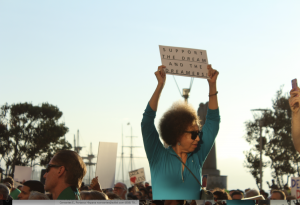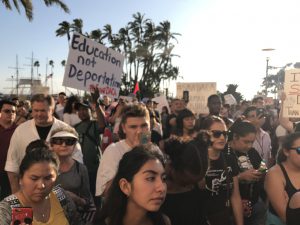Rescinded DACA Program Leaves ‘Dreamers’ with Uncertainty
Lee la historia en español

On Tuesday, Sept. 5, President Donald Trump rescinded the Deferred Action for Childhood Arrivals program, commonly known as DACA, which has allowed nearly 800,000 undocumented individuals to work legally in the country and have protection from deportation.
The program has ended, but with a six-month window, meaning that some who need to renew their work permits have until Oct. 5 to submit their request. However, this only applies to DACA recipients whose work authorization cards will expire between Sept. 5 and March 5, 2018.
Those who renew their applications will have a valid work permit and be protected from deportation until the expiration of their case and permit, Immigrant Legal Resource Center Staff Attorney Allison Davenport said during a national press call.
Davenport said the immigrant community should understand that if their DACA will expire in the six month window, they should apply to renew before the deadline.
“A general recommendation for everyone is to get legal consultation to understand their options,” Davenport said. “It could be that someone who has DACA is eligible for another immigration benefit and they don’t know it or maybe they do know it and they’ve been kind of putting off starting the application process because they have DACA. This is a really important moment for people to go and do a consultation with a quality legal service provider to understand their options.”
No new applications will be accepted as of Sept. 6, only renewals and applications submitted prior to the announcement will be processed for consideration.
And advanced parole, which allowed DACA recipients to travel outside of the United States for approved reasons, is no longer available.
The 2012 Obama-era program allowed undocumented individuals who arrived to the United States as children to apply for work permits to work legally in the country, to have protection from deportation, and in some states like California, apply for a driver’s license or identification card.
For some like Luis Quiroz, 27, who was brought to the U.S. when he was six months old, DACA allowed him to pursue a higher education, obtain a job, and have a sense of identity by getting a driver’s license, he said.
Quiroz said he found out that DACA had been rescinded while he was on his way to school and he began to cry uncontrollably after hearing the news.
“Personally I wasn’t prepared for the emotional distress,” Quiroz said.
Quiroz grew up in San Diego and moved to San Francisco to attend San Francisco State University. He said that the immigrant community shares the feeling of uncertainty and although they know DACA has ended, there is still the uncertainty if Congress will act during the six month period.
“Our livelihoods are constantly at stake in political games,” Quiroz said.
Those who opposed the program believed that it was an overreach of the executive branch to grant this group of individuals protection against immigration laws.
During his presidential campaign, President Trump promised he would end the program but had a different message once in office. In a February news conference, President Trump said he would show DACA recipients “great heart.”
Soon after, several states threatened to sue if the President did not end the program.
Attorney General Jeff Sessions formally announced on Tuesday that the program would end.
“To have a lawful system of immigration that serves the national interest, we cannot admit everyone who would like to come here,” Sessions said on Tuesday during a press conference. “That is an open border policy and the American people have rightly rejected it. Therefore, the nation must set and enforce a limit on how many immigrants we admit each year and that means all can not be accepted.”
He added, “This does not mean they are bad people or that our nation disrespects of demeans them in any way. It means we are properly enforcing our laws as Congress has passed them.”
President Donald Trump tweeted on Tuesday, “Congress now has 6 months to legalize DACA (something the Obama Administration was unable to do). If they can’t I will revisit this issue!”
The announcement of the end of DACA spurred numerous nationwide protests and a lawsuit filed in the Eastern District of New York.

On Tuesday, hundreds gathered at the San Diego County Administration Building, to show support for the individuals known as DREAMers.
Ana Hernandez, a student as San Diego State University, shared with the crowd that she arrived to the U.S. at the age of six and that she was one of the 800,000 DREAMers who would be affected by the decision announced earlier that day. But despite this newfound uncertainty, she gave a message of hope.
“Stand strong, stay resilient, and remember, papers do not define us, DACA does not define us, Dream Act does not define us, we are still undocumented, unafraid and unapologetic,” Hernandez said during the rally.
There are several pending legislative options that Congress could take to address the status of DREAMers including the Dream Act, the BRIDGE Act, the American Hope Act, or Recognizing America’s Children Act.
According to a release by the U.S. Department of Homeland Security, the information provided to the agency in DACA requests will, “not be proactively provided to ICE and CBP for the purpose of immigration enforcement proceedings” unless the individual meets criteria in the USCIS’ Notice to Appear guidelines, which are mainly related to national and public safety.






